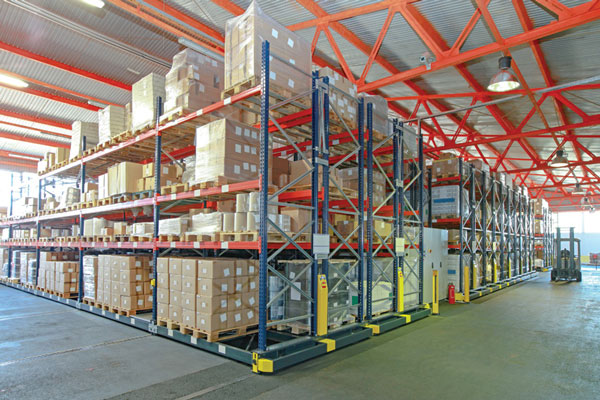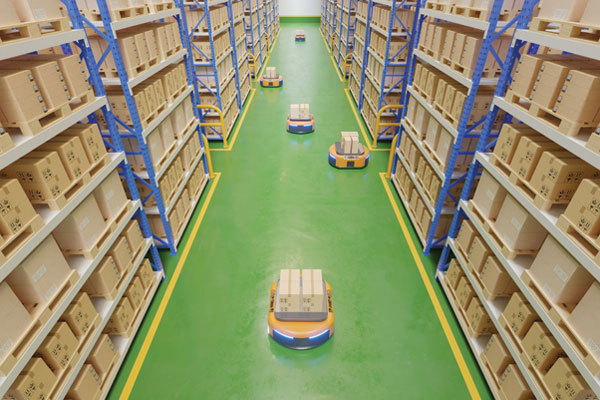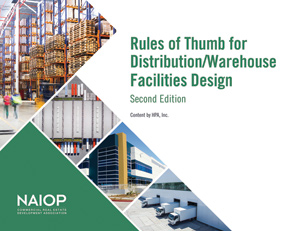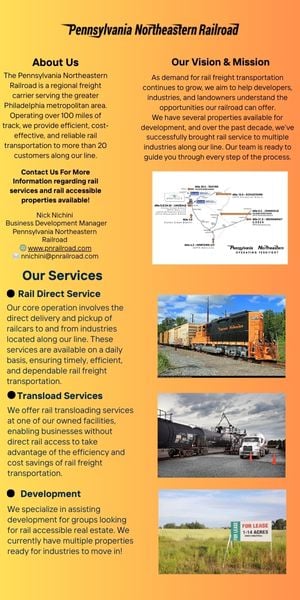Industrial Emerges from Pandemic in Relatively Good Health

Panelists at NAIOP’s I.CON Virtual 2020 shared good news about the sector’s resilience.
When the COVID-19 pandemic struck the U.S. earlier this year, it was unclear what the effects would be on industrial real estate. But nearly six months into the crisis, it appears that the sector has been more resilient than others.
The pandemic was a significant topic during NAIOP’s I.CON Virtual 2020, which was held online in June.
“I don’t think we’re immune to what’s happened, but we’ve held up well,” said David Fazekas, a senior managing director with the Black Creek Group, during a panel discussion at the event.
E-Commerce Booms
An explosion in e-commerce activity at the height of the pandemic, when much of the country was under stay-at-home orders, is a major factor behind the industrial sector’s stability. According to payments processer ACI Worldwide, global e-commerce sales rose 28% in June 2020 compared to June 2019. That was the largest year-over-year increase in sales since COVID-19 restrictions were put in place in March.
“Accelerated adoption of e-commerce was definitely a positive trend of the pandemic,” said Michael Coppola, a partner with Bluewater Property Group. “E-commerce has changed our industry. We’ll all be attuned to how much of that sticks.”

Most U.S. industrial development remains in the big-box space. Roughly 50% of construction in the first quarter was in the 500,000-square-foot format. Getty Images
Although JLL expects that online sales will decline from a recent peak of 26% of all sales, they will likely remain in the low 20s for the near future. This should lead to continued demand for last-mile facilities.
“Is e-commerce going to save us all?” JLL President of Industrial Brokerage Craig Meyer asked rhetorically during another panel at I.CON Virtual 2020. “For the time being, probably yes.”
According to Barbara Perrier, vice chairman with CBRE, COVID-19 accelerated the e-commerce trend by five years.
“Everybody talks about Amazon, but companies like Walmart, Target and Costco have really gained market share during this period,” she said.
Jeremy Giles, global head of customer-led solutions for Prologis, said the current crisis has led to growth not only in total online sales volume, but also in the number of e-commerce customers, and that related demand growth will likely be sticky. Along those lines, panelists noted that demand for industrial space held up well during the crisis, and e-commerce giant Amazon is a significant reason for that. The company added 175,000 employees at a time when more than 30 million Americans were out of work.
“The space that is coming online is getting gobbled up by Amazon,” Coppola said. “That’s certainly going to help rent growth.”
Amazon has taken at least 25 million square feet of space so far in 2020, and that doesn’t include what the company has in escrow. Third-party logistics providers and logistics companies are also taking vast swaths of inventory, as well as spaces suited for the reshoring of manufacturers.
Opportunities and Markets
Coppola said that his company, which is focused on the Northeast, looks to continue investing in that region.
“These Tier 1 infill markets are insulated from long-term trends that COVID-19 is not going to change,” he said. “COVID has only accelerated a lot of those trends. We don’t see anything in the way of distress, unless it’s a one-off like a retailer or someone with liquidity needs. We’re in a bit of a wait-and-see period. Buyers are being appropriately cautious right now.”
Fazekas said values have held up really well in industrial space, despite a lack of data points because of closures related to the pandemic.
“We were really worried about how we were going to get surveys and titles recorded with courthouses closed,” he said. “We had a few hiccups along the way, but we were able to navigate that. Inspection and permitting were delayed, but most municipalities quickly moved to virtual, which was surprising.”
Other panelists echoed that sentiment.
“We were impressed with municipalities that really adapted better than we thought they would, whether with Zoom or teleconference meetings,” Coppola said.
The panelists all agreed that lenders are more cautious in the current climate.
“They’re still in a bit of triage mode trying to figure out their mandates going forward,” Coppola said. “Caution is definitely the word in the lending market now. If you get a loan, it’ll probably have some kind of recourse tied to it. That’s why relationships are more important than ever.”
Fazekas agreed.
“Spreads have widened,” he said. “Leverage levels have increased. We’ve gotten more requests for recourse.”
Prior to the pandemic, both the economy and the market for industrial properties were strong. Most U.S. industrial development remains in the big-box space. Roughly 50% of construction in the first quarter was in the 500,000-square-foot format.
“Going into late February, it was as robust a capital markets environment as I’ve ever seen,” said Nicholas Pell of Link Industrial Properties. “There was a deep buyer pool and a scope of assets for buyers to pursue. Then COVID hit, and everything sort of stopped overnight.”
Perrier concurred.
“At the beginning of 2020, we all thought it would be a banner year,” she said. “Then it all halted, and the only thing moving was singletenant, long-term deals in core markets.”

Automation and robotics are playing bigger roles in industrial properties. However, these technologies can use a lot of electricity. Getty Images
Fortunately, the pause was short and far less damaging than initially projected.
“The East Coast and West Coast have snapped back quickly, and the center of the country is getting there, but just not quite as fast,” said James Clewlow of CenterPoint Properties. “Leasing was off some, but a lot depended on the market and what level of shutdown was happening there. For example, Houston was very strong all the way through, and so was Florida.”
CBRE is seeing positive leasing activity too, said Perrier, and broker sentiment is high.
“The winners are those with great locations,” said Clewlow. “The ‘location, location, location’ adage is very applicable to industrial today. Companies like Amazon and Wayfair want to be near their customers, and the issue is what kind of building works for them. Does it have to be new? Not always.”
The demand for these prime spaces is reflected in rents. There are rent spikes for the best locations and challenges for the worst.
“A building may be functional by all standards but not in the right location, and those are the ones slower to lease,” Clewlow said.
Traditional multitenant industrial business parks are also still emerging from COVID’s impact.
“A lot of those deals were shelved because of uncertainty on the rent roll,” said Perrier. “Disruptions were short term, and collections have been strong at 90%-95%. We expect to start seeing multitenant parks coming back online soon, with very active third and fourth quarters.”
Investors are still eager for deals. Pell said Link has actively pursued deals too, closing $1.9 billion in acquisitions and selling $900 million in dispositions this year.
There’s a lot of capital chasing infill markets, especially if pricing is right, noted Perrier, referencing large site sales that CBRE just completed near both Los Angeles International Airport and Hawaii’s Port of Oahu.
“A lot of lenders want to get into industrial space, and it’s a good opportunity now because it’s a safe haven,” she said.
With regards to deal flow between Tier 1 and Tier 2 markets, Perrier said she believes Tier 1 has returned to pre-COVID pricing, but there is differential in Tier 2.
“My sense is that the definition of what’s Tier 1 and Tier 2 is changing,” she said. “It’s going to be tied more to where population is, because of e-commerce.”
Perrier also predicts a shift in retail conversions to industrial space to accommodate the last mile, which will necessitate conversations with cities and municipalities that will see fewer sales tax dollars but will benefit more from occupied spaces rather than vacant ones.
Investing Outside the Big Box
While multimillion-dollar projects in prime industrial markets may make headlines, 85% of industrial transactions come in under $20 million and are taking place in secondary and tertiary markets throughout the U.S. A session at I.CON Virtual 2020 focused on the investment dynamics of this vast, active and diverse sector within the industrial market.
The industrial market benefits from the massive growth trajectory of e-commerce, as online sales growth outpaces traditional retail sales. With brick-and-mortar stores closed due to the pandemic, it’s hardly surprising that this trend has accelerated — and the rate of growth is astounding.
“It’s a trend that’s already in place but it’s a COVID-accelerated trend,” said Al Pontius, senior vice president and national director, office and industrial, healthcare and special assets with Marcus & Millichap.
The global health crisis has exposed flaws in the increasingly interlinked supply chain, Pontius said, which could lead to more U.S. onshoring of manufacturing to curtail some of these risks.
Other potential outcomes:
- Industrial demand may increase as diversification in sourcing, routing and distribution becomes more important.
- There will be a thorough review of “just in time” supply chain systems as businesses weigh redundancy vs. efficiency.
- There may be increased industrial and warehousing demand as companies expand inventories to accommodate greater “safety stock.”
Industrial construction for the first quarter of 2020 remains highly concentrated in top markets like the Inland Empire, Dallas-Fort Worth, Houston, Chicago, Atlanta, Phoenix, and several other metro areas as measured by completions, according to Marcus & Millichap Research Services and CoStar Group data.
Meanwhile, industrial supply pressure was reduced in smaller metros like Milwaukee, Salt Lake City, Las Vegas, Detroit and Columbus, Ohio.
“It is interesting how Detroit, over the last 10 years, really snuck up on the marketplace,” Pontius said. “A lot of people had written off Detroit.”
The city had a 3.8% industrial vacancy rate in the first quarter of 2020 with completions as a percentage of inventory of just 0.8%.
“Columbus, Charleston, Salt Lake City…I’m seeing these as hot spots,” said Curtis Spencer, president of IMS Worldwide. Spencer noted that cities like Columbus have done well throughout the COVID-19 crisis thanks to excellent logistics locations and infrastructure. He called Charleston, South Carolina, which is a base for Volvo and Mercedes, “a real sleeper” and said the city has several new deliveries being made for build-to-suit opportunities.
Pontius noted that U.S. industrial development remains primarily in the big-box space; 50% of construction in the first quarter was in the 500,000-square-foot format. In select markets (such as Charleston, Denver and Detroit), it’s even more pronounced — up to 54%.
“We have to distinguish between the pre- and post-COVID economy as the U.S. economy struggles to regain its footing following the initial devastation caused by the pandemic,” said Michael Brennan, chairman and managing principal of the Brennan Investment Group. “These smaller markets have a user demand that’s on par with the rest of the nation.”
The driving force behind it is ecommerce, he said.
“E-commerce demand is broadbased, so you’re seeing absorption numbers in smaller markets that are sort of identical to the larger market overall,” Brennan said. “Some of these markets that most people had written off are coming back and in a significant way — you wouldn’t have seen that 10 or 15 years ago. This is a different pattern of absorption than the nation has seen before.”
Spencer agreed.
“Even though these markets have a lot of similarities in terms of the product size, you are also seeing that rent rates are nearly the same,” he said. “The similarities between the primary and secondary or tertiary markets blew my mind. As an investor, or broker or lender, this may help you expand your opportunities.”
Building Design
The design and constructability of industrial projects has changed immensely over the past decade, alongside growing e-commerce demand, population density and trends like grocery delivery.
Robert Murray, senior vice principal at Alston Construction, noted that buildings are getting taller; 40-foot clear buildings are now commonplace, and 48-foot clear buildings are increasingly entering the market. Taller buildings are also becoming more common in last-mile facilities located close to dense urban areas.
There is also greater adaptation of robotics and autostore systems to increase building throughput. However, automated systems and HVAC systems also sometimes require the installation of additional sprinkler systems and have contributed to increased electrical requirements in buildings. Murray observed that new buildings with automated systems frequently require the installation of three or four transformers and large backup generators to ensure that systems can remain in operation during a power outage.
Space usage at a site is also beginning to shift. Many facilities, especially those in the last-mile category, can now accommodate additional parking for delivery vans and workers. Conventional buildings are still being built with 50-foot bays to service truck deliveries, but buildings increasingly use truck queueing systems to allow more onsite space to be devoted to parking.
Jinger Tapia, principal, design at Ware Malcomb, noted ways that buildings are being designed to be more flexible and identified design elements that can allow for more efficient use of space. For example, to accommodate a future change of use, designers can ensure that a wall initially designed for truck docking is not load-bearing so it can be reconfigured or moved.
Tapia also outlined potential approaches to making large buildings “more efficient on smaller acreage of land, closer in to the buyers who are looking for delivery.” These include placing loading zones in a central corridor along the middle of a building instead of at a building’s sides, and surrounding each side of a loading zone with mezzanines and vertical lifts.
Tapia and Brook Melchin, a senior architect/director at Riddell Kurczaba, observed that there has been a recent trend toward increased building amenities and designing buildings for occupant health and wellness, a trend they expect to accelerate in the wake of COVID-19.
Tapia indicated that these trends are similar to those occurring for attracting and retaining employees at office buildings; tenants are increasingly interested in providing employees with amenities and attractive external spaces. “In years past, it was minimal landscape,” he said. “Now we are seeing plans on various levels of industrial to add amenity spaces and walkable paths and connecting with nature.”
Melchin said he expects that social distancing will also become a longterm design consideration, and that this will lead to a new pandemic certification for buildings that is based on a wellness framework.
Trey Barrineau is the managing editor of publications at NAIOP. Kathryn Hamilton is vice president of marketing and communications at NAIOP. Shawn Moura, Ph.D., is research director at NAIOP. Marie Ruff and Brielle Scott are communications senior managers at NAIOP.
Future CRE Leaders Share Thoughts on I.CON Virtual 2020Because of the COVID-19 pandemic, NAIOP’s I.CON event was hosted online. A group of Prologis interns were invited to attend, and they shared their impressions of the virtual conference. Madison Strasmann, University of California, Berkeley Caitlin Ramirez, University of Michigan Jackie Chan, University of California, Berkeley Tommy Waller, UCLA |
NAIOP’s New E-Book: ‘Rules of Thumb for Distribution/Warehouse Facilities Design’ Do you ever lie awake at night wondering what the functional width of a truck yard is? Do you yearn to know more about the thickness, curing and sloping of slab floors? Or how to prevent condensation from forming under a warehouse roof? Answers to these questions and more can be found in NAIOP’s new 60-page e-book, “Rules of Thumb for Distribution/Warehouse Facilities Design,” now available for sale on the association’s website. Originally published in 2005, the book has been significantly updated and expanded to include new information and illustrations on industrial site design, floors, racking systems and aesthetics. Author Byron Pinckert of HPA, Inc. observes that, in the past 15 years, the guidelines for industrial properties haven’t changed as much as they’ve been extended. “In 2005, a large distribution center building had a footprint of a few hundred thousand square feet,” he said. “Today, a large building is in the range of a million square feet. The 2020 rules of thumb extend the guidelines from the 2005 edition to illustrate all the new approaches to optimize this new scale of facility.” “Rules of Thumb” provides not only the numbers behind successful warehouse design but also the reasons for these recommendations. “This book doesn’t just say the appropriate depth of a truck yard is 130 feet, it explains why it is 130 feet and under what circumstances it would make sense to be something different than 130 feet,” Pinckert said. “Both industrial real estate developers and brokers will be able to use this information to have more meaningful dialogue with end-users.” |




